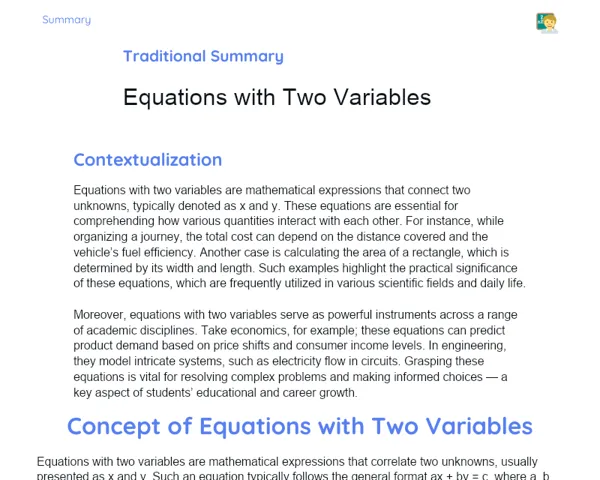Socioemotional Summary Conclusion
Goals
1. Recognise that the basic facts of multiplication are simply operations that serve as a stepping stone for tackling more advanced mathematical challenges.
2. Perform simple multiplication tasks, for instance calculating 4 x 3 = 12.
Contextualization
Have you ever noticed how multiplication appears in our daily routines? Whether it’s sharing a plate of samosas with friends or figuring out the total minutes in several hours, having a good grasp of basic multiplication definitely makes solving problems quicker and more efficient. Let’s explore this delightful area together and see how mastering multiplication can simplify and even add a bit of fun to our lives!
Exercising Your Knowledge
Definition of Multiplication
Multiplication is a mathematical process that involves combining equal groups. For example, when we say 4 x 3, it means there are 4 groups containing 3 items each, resulting in a total of 12 items. Understanding this concept lays a strong foundation for dealing with more complex problems as multiplication is key to advanced mathematics.
-
Multiplication essentially means adding equal groups repeatedly – 4 x 3 indicates 4 groups of 3 items each.
-
It is very useful in everyday situations, like dividing things equally among friends.
-
It forms the base for more complex operations, including division and algebra.
Terms of Multiplication
In multiplication, we use particular terms such as 'factors' and 'product'. Here, the factors are the numbers that are multiplied, while the product is the outcome of that multiplication. Knowing these terms well helps in expressing mathematical ideas clearly and confidently.
-
Factors are the numbers we multiply together, for example, 4 and 3 in 4 x 3.
-
The product is the result you get from the multiplication, like 12 in 4 x 3 = 12.
-
A firm grasp of these terms makes solving and explaining mathematical problems much easier.
Properties of Multiplication
There are some important properties in multiplication that make the operation easier to understand and apply. The most notable ones are the commutative and distributive properties. The commutative property tells us that the order in which we multiply numbers does not change the outcome, while the distributive property helps in multiplying a number by a sum.
-
Commutative Property: The order of factors does not affect the product (for example, 4 x 3 is the same as 3 x 4).
-
Distributive Property: Multiplying a number by a sum is equivalent to multiplying the number with each addend individually and then adding the results (for example, 4 x (2 + 3) equals 4 x 2 + 4 x 3).
-
These properties make it easier to work with numbers in flexible ways.
Key Terms
-
Multiplication: A mathematical operation that combines equal groups.
-
Factors: The numbers that are multiplied together to obtain a product.
-
Product: The result of the multiplication.
-
Commutative Property: The principle that the order of factors does not affect the product.
-
Distributive Property: A property which states that multiplying a number by a sum is the same as doing each multiplication separately and then adding the results.
For Reflection
-
How did you feel when you were introduced to this new mathematical concept? Were you nervous, confident, or simply curious? Why do you think so?
-
Can you relate the understanding of basic multiplication facts to other aspects of your life? In what ways?
-
Recall a moment when you used multiplication without even realising it, such as when dividing something among friends or counting items. How did that help you then?
Important Conclusions
-
Basic multiplication facts are crucial for understanding more complex mathematical operations.
-
Being able to perform simple multiplications like 4 x 3 = 12 is a fundamental skill that we employ in our daily lives.
-
Knowing the terms like factors and product makes it much simpler to solve mathematical problems.
-
Properties such as the commutative and distributive properties make multiplication a more flexible and clear process.
-
Learning multiplication not only sharpens your mathematical abilities but also enhances your problem-solving and decision-making skills.
Impacts on Society
Multiplication is a skill that we use almost every day, sometimes without even realising it. Whether you are sharing snacks with friends or calculating the money needed for a purchase, understanding basic multiplication makes these everyday tasks simpler and faster. Furthermore, mastering multiplication builds the confidence to take on other mathematical challenges and everyday situations.
On a broader note, studying multiplication also helps in nurturing socio-emotional skills. For instance, when you collaborate with peers on multiplication problems, you enhance your teamwork and decision-making abilities while also developing an awareness of how your actions affect others.
Dealing with Emotions
To help manage your emotions while studying multiplication, try using the RULER approach at home. First, recognise your feelings when you face multiplication problems – do you feel nervous, confident, or perhaps a little frustrated? Next, understand why you feel that way and consider what impact these emotions have. Accurately naming and expressing your emotions, perhaps by discussing them with a friend or an older person, can be very helpful. Finally, regulate your emotions by taking deep breaths, pausing to relax, or recalling previous successes in math.
Study Tips
-
Make and use flashcards for practicing basic multiplication facts. Create cards with different multiplication questions and their answers to test your knowledge.
-
Dedicate a few minutes every day to practice multiplication, whether it’s through online games, educational apps, or exercises from a math book.
-
Find fun ways to incorporate multiplication in daily life, such as counting everyday items or sharing food with friends.



